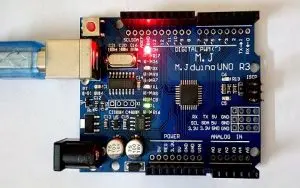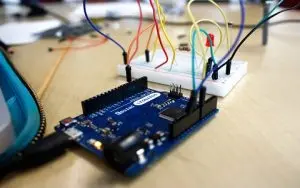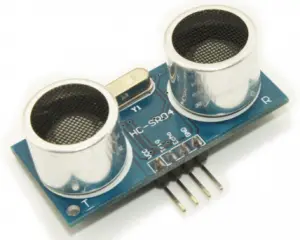The Arduino UNO, developed around the ATmega328P microcontroller, boasts a versatile array of features. With 14 digital I/O pins, including 6 PWM outputs, along with 6 analog inputs and a 16 MHz quartz crystal, it offers ample flexibility for various projects. Additionally, it comes equipped with essential components such as a USB connection, a power jack, an ICSP header, and a reset button, making it a user-friendly, plug-and-play device.
Getting started with the Arduino UNO is straightforward. Users can simply connect it to their computer via USB or power it using an AC-DC adapter or battery. Programming the Arduino UNO requires the Arduino IDE, which must be installed on the computer. Once installed, users can write and upload programs effortlessly, as the ATmega328P comes preprogrammed with a bootloader, eliminating the need for an external programmer.
This article presents a compilation of Arduino UNO projects tailored for beginners and engineering students, providing a comprehensive resource for exploring the potential of this versatile microcontroller platform.
Simple Arduino Uno Projects for Beginners
Below are a few intriguing Arduino projects suitable for beginners. After installing the Arduino software IDE, establish a connection between the Arduino UNO board and your computer via USB. Within the IDE, navigate to “TOOLS,” then “BOARD,” and choose the appropriate board from the dropdown menu. Next, select the port by going to “TOOLS” and choosing the port labeled as “ARDUINO.”

Blink an LED
The necessary hardware components include:
1. Arduino UNO board
2. Breadboard
3. Jumper wires
4. LED
5. 220Ω resistor
6. USB cable
Here are the steps to set up the hardware:
Step 1: Connect the black jumper wire from the ground pin on the Arduino to row 15 on the breadboard.
Step 2: Connect the red jumper wire from pin 13 on the Arduino to column F, row 7 on the breadboard.
Step 3: Insert the long end of the LED into row 7, column H on the breadboard.
Step 4: Insert the short leg of the LED into row 4, column H on the breadboard.
Step 5: Connect one end of the resistor to row 4 in the Ground rail of the breadboard, and the other end to row 4 in column I.
After making these connections, proceed with programming the Uno:
1. Open the Arduino IDE.
2. Access the built-in programs by selecting FILE, then EXAMPLES, then BASICS, and finally BLINK.
3. This will open the Blink LED program.
4. Verify the program for any errors by clicking the verify button at the top left of the IDE box.
5. Once the message “Done Compiling” appears, the program is ready for use. Click the upload button to upload the program to the Arduino board.
6. The built-in LED on the Arduino board will flash rapidly for a few seconds, indicating that the program is executing. If there are no errors, the LED on the breadboard will turn on for a second, then turn off for a second, continuing in a loop.
By following similar steps and selecting different code options, and customizing the required hardware components, one can work with the Arduino Uno hassle-free.
Arduino Uno Test
This project offers a straightforward and fundamental electronic endeavor. Utilizing an Arduino Uno, it enables the assessment of the Uno board’s functionality by activating an LED directly linked to the board.
Designing a Push Button to Turn ON and OFF a LED
You can create this straightforward push-button project using an Arduino Uno. The push button switch is employed to toggle an LED, turning it on and off.
Designing a Potentiometer to Change the Resistance Values of an LED
A potentiometer circuit compatible with an Arduino Uno can be constructed on a breadboard. This straightforward project is designed to regulate LED resistance, allowing for control over the LED’s frequency simply by adjusting the knob.
LED Scrolling
The LED scrolling project described here involves the blinking of six LEDs simultaneously or in a back-and-forth pattern. This circuit design draws inspiration from the iconic Knight Rider show, where a car featured looping LEDs.
Arduino to Increase or Decrease the Intensity of the LED
This straightforward LED fade project is crafted for use with an Arduino Uno board. Utilizing a PWM pin on this board allows for the modulation of LED intensity, enabling smooth adjustments in brightness levels.
Arduino Uno LCD Display Project
This project utilizes an Arduino Uno board to create a liquid crystal display (LCD) screen. The display is capable of showcasing text on its surface. With this project, phrases such as “Hello World” can be showcased on the LCD. Additionally, a potentiometer is integrated to allow for contrast adjustment on the display.
DC Motor Control
This project utilizes an Arduino Uno for controlling the speed of a DC motor. It involves adjusting the motor’s speed through a switching transistor. With accurate connections on the breadboard, successful motor rotation can be achieved.
Arduino Uno Projects for Engineering Students
Below are a collection of Arduino project ideas intended for engineering students to explore and experiment with.

Included in the compilation of Arduino Uno projects for engineering students are the following options.
Arduino Uno GPS Tracker Project
The implementation of this project involves utilizing an Arduino Uno and GPS technology to monitor vehicle movement. A GSM modem equipped with a SIM card facilitates communication within the system. This setup can be installed within a vehicle, enabling straightforward tracking in case of theft using a mobile phone. Additionally, the application extends to tracking college or school buses for enhanced monitoring and security purposes.
Driverless Metro Train Using Arduino-Uno
Historically, metro train accidents have been attributed to various factors, including human error by drivers, signal malfunctions, and challenges in manual operation. In response to these issues, a solution has been devised in the form of a driverless metro train, built with Arduino Uno technology. This innovative approach enhances railway network management, mitigating human errors and minimizing power consumption to ensure safety and comfort for passengers during travel.
Arduino Uno Project Smart Dustbin
The purpose of this project is to create an intelligent waste management system utilizing the Arduino Uno board. It aims to address the issue of overflowing garbage along roadsides, promoting cleanliness and environmental sustainability. The system employs a routing algorithm to optimize garbage collection routes, minimizing the number of vehicles needed for efficient waste disposal.
Arduino Uno IR Sensor Project
This project involves the manipulation of light-emitting diodes (LEDs) through the utilization of an infrared (IR) sensor in conjunction with a remote control. Upon pressing a button on the remote, an IR signal is emitted and received by the IR sensor in the form of code. Subsequently, the sensor detects and relays this signal to the Arduino for further processing.
Arduino Uno Project using Vending Machine
The aim of this project is to create a vending machine utilizing Arduino Uno technology, incorporating an RFID system. Upon swiping an RFID tag across the RFID reader, a predetermined quantity of liquid is dispensed. An alphanumeric LCD display is employed to provide instructions and guide users through the liquid dispensing process. This machine finds applications in various settings such as colleges and hospitals, offering automated service to customers without the need for human intervention.
Music Instrument using Arduino
The objective of this project is to create a musical instrument utilizing Arduino Uno, controllable via hand gestures. Hand gestures are detected using a flick board, enabling recognition in three-dimensional space up to a distance of 15 centimeters.
With a simple flick of the wrist, it becomes possible to control various home appliances such as the music system, TV, computer, and more. This project involves designing a musical instrument utilizing an Arduino Uno and Flick.
Door Lock based on Fingerprint and Arduino Uno
This project entails the creation of a door lock system that utilizes fingerprint recognition. With this system, doors can be unlocked by scanning fingerprints. The purpose of this project is to enhance security by eliminating the need for traditional key-based lock systems, which are prone to vulnerabilities. In this setup, the door unlocks when a fingerprint is scanned on the door lock mechanism.
Robot Car
The objective of this project is to create a robotic vehicle utilizing Arduino Uno. The vehicle incorporates a DC motor, controlled by Arduino Uno in conjunction with a Motor Driver IC.
Home Automation using Arduino Uno
The aim of this project is to create a convenient home automation system for controlling household appliances. By utilizing an Android app, a selection of modules, and an Arduino Uno, users can easily manage their electrical devices. This system enables the control of appliances through voice commands via Bluetooth connectivity.
Arduino Uno Projects with Sensors
Below are discussions on projects involving Arduino Uno and sensors.
Thermometer using LM35 Sensor & Arduino Uno
Accurate temperature monitoring is crucial in various environments. This data is utilized for temperature regulation in industries, computer CPUs, incubators, and numerous other applications. To achieve this, a properly configured temperature sensor is employed to trigger actions when the ambient temperature surpasses or falls below a set threshold. Hence, the LM35 temperature sensor is employed in the development of the Didactic Thermometer.
Arduino Uno & IR Sensor-based Automatic Gate Opener
Currently, there has been a surge in the adoption of automation systems. Alongside this trend, automatic gate door opening and closing mechanisms have been introduced. When an individual approaches the gate, it automatically opens upon detecting their presence and closes on its own. This system is suitable for both main gates and car garages.
Mini Weather Station
The objective of this project is to create a compact weather station utilizing Arduino Uno. The station utilizes a WiFi connection to upload data to the ThingSpeak platform. It gathers various data such as temperature, light intensity, atmospheric pressure, and humidity through distinct sensors.
Soil Moisture Sensor using Arduino Uno
Within this project, the Arduino Uno board is integrated with a soil moisture sensor. Operating within a voltage range of 2 to 5 volts, this sensor has a detection length of 38mm. Resembling a fork, it can be effortlessly inserted into the soil. Its primary function is to gauge the moisture content of the soil. As the soil moisture rises, so does the analog output voltage.
Window Alarm Annunciator
The purpose of this project is to create a window alarm system using Arduino Uno. The primary function of the alarm system is to notify operators in power plants and industries about abnormal situations or variations in parameters.
Audio Meter using Arduino Uno
The objective of this project is to create an audiometer utilizing an Arduino Uno and an LCD display. The audiometer is designed to incorporate a Standard Volume Indicator (SVI) or VU meter, commonly used in audio devices to visualize signal levels. In this system, the Arduino Uno receives input from two channels, representing right and left audio signals, which are then depicted as bars on the display. Analog input pins on the Arduino Uno board are employed to accurately measure the levels of the audio signals in this project.
Alarm Clock using Arduino Uno
The project involves creating an alarm clock using an Arduino Uno. This straightforward endeavor incorporates an LCD display along with a real-time clock (RTC) module. Designing the entire project can be accomplished by utilizing a prototyping shield in conjunction with a power supply. A piezoelectric buzzer is employed to produce sound during specified time intervals.
Wi-Fi Controlled Robot
This project involves the creation of a WiFi-controlled robot. Utilizing the ARMA IoT shield and the Blynk App, users can control the robot from anywhere. The Arduino Uno board connects to WiFi via the ARMA IoT shield, enabling control through the Blynk app, compatible with both Android and iOS platforms.
GPS Clock using Arduino Uno
This project involves creating a clock using GPS technology and Arduino Uno. GPS-enabled clocks offer precise timekeeping and find applications in various public settings such as airports, bus terminals, and train stations. They are particularly valuable in military contexts due to their reliability and accuracy.
Below are additional project ideas utilizing Arduino Uno, which can serve as valuable learning experiences for engineering students:
1. Arduino Uno:
– Development of a driverless metro train system using Arduino Uno.
– Construction of an odometer.
– Creation of a color mixing lamp.
– Implementation of a Light Theremin.
– Design of a keyboard instrument.
– Building a Digital Hourglass.
– Development of a Collision Avoidance Drone.
– Construction of a Snake robot.
– Design and implementation of an Arduino-based color sorter.
– Creation of an Arduino solar tracker.
– Installation of a Fire Alarm system.
– Establishment of a Heart rate measuring system using IR sensors and Arduino Uno.
– Measurement of power and energy using Arduino Uno.
– Development of a high-efficiency dual-axis solar tracking system with Arduino.
– Implementation of an intelligent smart home automation and security system using Arduino.
– Continuous monitoring of heart rate and body temperature using Uno and Android devices.
– Integration of smart farming techniques using Arduino and data mining.
– Investigation of simple harmonic motion using Arduino.
– Development of an inexpensive LED simulator for vision research using Arduino.
– Establishment of wireless RF communication between two Arduino devices.
– Creation of an indoor positioning system using visible light communication and ultrasound with Arduino.
– Implementation of a smart energy meter for advanced metering and billing using Arduino and GSM.
– Design and deployment of a smart RFID security and attendance system with audio acknowledgment using Arduino.
– Creation of a low-cost portable oscilloscope based on Arduino and GLCD.
– Development of a smart electronic wheelchair using Arduino and Bluetooth.
– Design and deployment of a gas leakage monitoring system using Arduino and ZigBee.
– Construction of an automated hydroponics nutrition plant system using Arduino Uno controlled by an Android device.
– Implementation of an air ventilation system for server room security using Arduino.
– Establishment of a Brain-Computer Interface (BCI) using Arduino.
– Creation of a surveillance robot using Arduino microcontroller.
– Development of an environmental monitoring framework with Arduino-based sensors using a RESTful web service.
– Implementation of a real-time battery monitoring system using LabView interface for Arduino.
– Creation of a wireless intrusion detection system using IR sensors and GSM with Arduino.
Arduino UNO Projects using Ultrasonic Sensor
Below is a compilation of Arduino Uno projects that incorporate an ultrasonic sensor.

4WD Smart Robot Car
This project entails the creation of a Smart Robot Car capable of navigating around obstacles and adhering to specified directions to reach its destination. The car can operate either autonomously or manually through the utilization of a Bluetooth module. The hardware components employed in this project include an Arduino UNO, Dual H bridge motor driver, Ultrasonic sensor, Bluetooth module, Contact avoidance sensor, Line Tracking sensor, and Li-Ion battery.
Door Alarm using an Ultrasonic Sensor & Arduino Uno
This project aims to create a door alarm system utilizing an ultrasonic sensor, which functions as a distance sensor. The primary role of this sensor is to gauge the distance between an object and the target area. Upon detecting someone within a specified distance, the system triggers a door alarm. Depending on the distance measured, the buzzer will automatically activate or deactivate.
Ultrasonic Range Detector
This project utilizes an Ultrasonic sensor paired with Arduino to measure distance without relying on a physical ruler. Much like how bats gauge distance through echolocation, this setup emits ultrasonic sound pulses and calculates distance based on the time it takes for the sound to travel to an object and return to the Ultrasonic receiver.
Below is a compilation of top Arduino Uno projects:
1. Motion detector camera using Arduino UNO.
2. Smart integrated belt for visually impaired mobility.
3. Trash talker system employing bolt IoT.
4. Door alarm system utilizing ultrasonic sensors.
5. Mini Acoustic Levitation setup.
6. Geiger counter simulator project.
7. Arduino HC-04 and 8×8 matrix MAX7219 project.
8. Water level alert system.
9. Automated clothes and shoe donation machine.
10. Automated ultrasonic car.
11. Arduino Soliton radar implementation.
12. Blind runner alarm – speed measuring device.
These projects showcase the versatility and adaptability of Arduino Uno, demonstrating its capability to integrate hardware and software seamlessly. Arduino’s open-source nature has made it a preferred platform for both students and professional engineers to explore and implement various technologies, including IoT. How has Arduino helped you bring your ideas to life?
